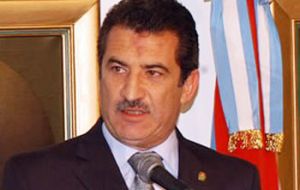MercoPress. South Atlantic News Agency
Argentine politicians warn Uruguay on possible expansion of pulp mill production capacity
 Entre Ríos province Governor Sergio Urribarri on the front line of protests
Entre Ríos province Governor Sergio Urribarri on the front line of protests The bilateral conflict between Argentina and Uruguay over the UPM/Botnia pulp mill, on the Uruguayan side of the Uruguay River is once again leading to tension between the two neighbours amid reports that the plant’s Finnish owners plan to increase production from 1.1 to 1.3 million tons of cellulose paste per year.
Argentine Entre Ríos province Governor Sergio Urribarri (and close ally of President Cristina Fernandez) raised questions about the reported planned increase, saying he had “requested clarification from the (Uruguay) government through the Foreign Ministry over the versions and statements from officials regarding the construction of a new plant and an expansion of UPM production limit.”
The request came a day after the Uruguayan National Environment Directorate (Dinama) released a report on water samples in the surrounding area of the pulp mill in the city of Fray Bentos, showing pollution in the river was within allowed limits.
Horacio Melo, the Argentine delegate in the bi-national River Uruguay Administrator Committee (CARU), said it “would be shameful” for Uruguay to unilaterally allow an increase in production at the paper mill, noting that the neighbouring country would “once again be burying the statute that rules on the operations of the Uruguay River.”
On Monday, former Uruguayan vice-president Luis Hierro, Uruguay’s representative in CARU, said that Dinama’s studies showed identical results to those by CARU, and that the latter institution was only prevented from publishing the data due to the lack of an agreement between the members of the bi-national committee.
“Let’s be honest: if by any chance the environmental reports from CARU were contrary to Uruguay, do you believe the Argentines won’t have them released to the world?”, said Hierro.
Although the Uruguayan president Jose Mujica announced UPM request at the Council of the Americas summit on August 16, he has refused to comment further on the plans.
However Uruguay’s Executive officials have said that complying with a request from the Argentine president, President Mujica will not make any decisions until after the October 27 mid-term elections in Argentina since all efforts are ‘concentrated on that issue’.
The Uruguayan media published over the weekend that fearing the wrath of Cristina Fernandez Uruguay had suspended a decision on the expansion of UPM/Botnia.
However this week President Mujica when asked about the issue admitted to have made a decision, which he is keeping to himself and will make public when the time comes.
The mill’s operations “have been placed under the continuing surveillance of CARU and the Scientific Committee, so the plant itself or Uruguayan authorities cannot authorize or implement changes unilaterally,” the Argentine CARU delegation stated with Melo arguing such actions “would be shameful.”
“An increase in production would mean an increase in pollution,” he said, adding: “Don’t come and tell me that phosphorus levels in the river — which are already high — won’t be higher with a 25% increase in production.”
Melo argued that the Hague’s International Court of Justice, which ruled in favour of Uruguay and UPM in 2010 and against Argentina, had “analyzed production of a million tons, so we must analyze this (new level of) production,” adding that “it would be an outrage to hike up the plant’s output without first completing air and water quality studies”.





Top Comments
Disclaimer & comment rules-

-

-

Read all commentsThe pollution levels at the moment in the Uruguay river are at the allowable levels EXCEPT in the outflow region of Gualeguaychu city main drainage!!!!!!!!!!!
Sep 05th, 2013 - 09:25 am 0This government must stop making trouble with our neighbours. It is only another way of providing a smoke screen to hide the economic and social disasters due to the kirchnerite plague!!!!!!!!!!
Exactly Simon. BTW, is CARP .Comision Administradora del Rio de La Plata, monitoring pollution levels in that estuary, particularly the untreated filth that Buenos Aires spewes out into the river ?
Sep 05th, 2013 - 09:52 am 0Somebody is going to have to explain to me how 0.2 million tons is 25% of 1.1 million tons. Still, 25% sounds so much worse than 18%, doesn't it? Why does Uruguay let itself get entangled in these bi-national organisations? Further south there is CARP (a very appropriate title considering argie involvement), Comisión Administradora del Río de la Plata, that has stalled the dredging of the Martin Garcia channel for over TEN years. A major obstruction for vessels trying to reach Nueva Palmira. That would be the second most important commercial port in Uruguay. Uruguay should withdraw from any bi-national bodies. One of the worst parts is that Uruguay has to tell argieland what it wants to do and present all sorts of data. Let argieland find out the hard way. When the production increases!
Sep 05th, 2013 - 10:06 am 0Commenting for this story is now closed.
If you have a Facebook account, become a fan and comment on our Facebook Page!